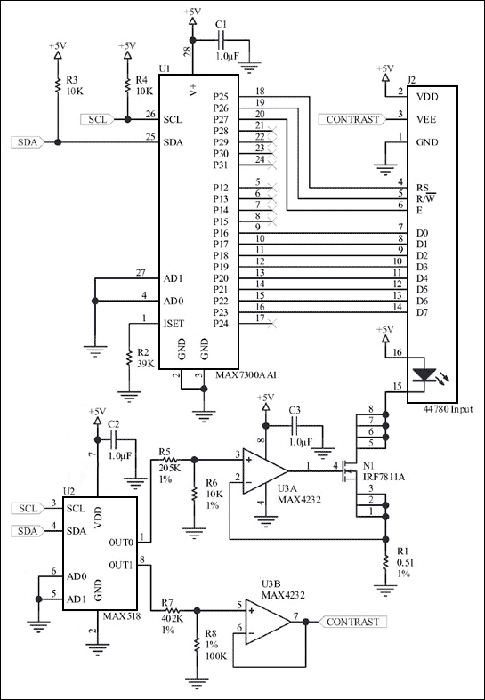Serializing an HD44780 LCD Display
要約
Besides reducing the number of required GPIO lines from eleven to two, this circuit also provides programmable contrast and backlight control.
Most LCD character displays connect to the outside world through a controller IC, such as the HD44780 (Hitachi) or equivalent. That interface has serious drawbacks, however. It uses up a large number of the microcontroller's general-purpose input/output (GPIO) pins, and it isn't capable of providing digital-contrast or backlight-intensity control.
The circuit in Figure 1 reduces the required number of GPIOs from eleven to two, and also provides digital control of the LCD's contrast and backlight intensity. A versatile I/O-port expander (U1) emulates the typical 8-bit I/O port of a microcontroller. You can implement this interface with little or no extra code if your microcontroller integrates an I2C peripheral. As an alternative, you can bit-bang the required signals through the regular GPIO pins.

Figure 1. Besides reducing the number of required GPIO lines from eleven to two, this circuit also provides programmable contrast and backlight control.
Op amp U3B buffers DAC output OUT1, which controls the contrast voltage. DAC output OUT0 controls a constant-current sink consisting of op amp U3A, MOSFET N1, and resistors R1, R5, and R6. This current sink draws 500mA when the DAC voltage output is at full scale.
You might need to adjust the maximum LED backlight current according to the size of the LCD display. To do that, use the following equations to calculate resistor values R1, R5, and R6:

where
VDD(min) = minimum anode supply voltage (4.5V typ),
VFLED(max) = maximum forward LED voltage,
IFLED(max) = maximum forward LED current,
RDS(ON) = on-resistance of switch N1,
VFS(DAC) = full-scale voltage output of DAC,
PR1 = minimum power rating of resistor R1, and
R6 = 10kΩ.
This application note appeared as a design idea in the June 9, 2005 issue of Electronic Design magazine.